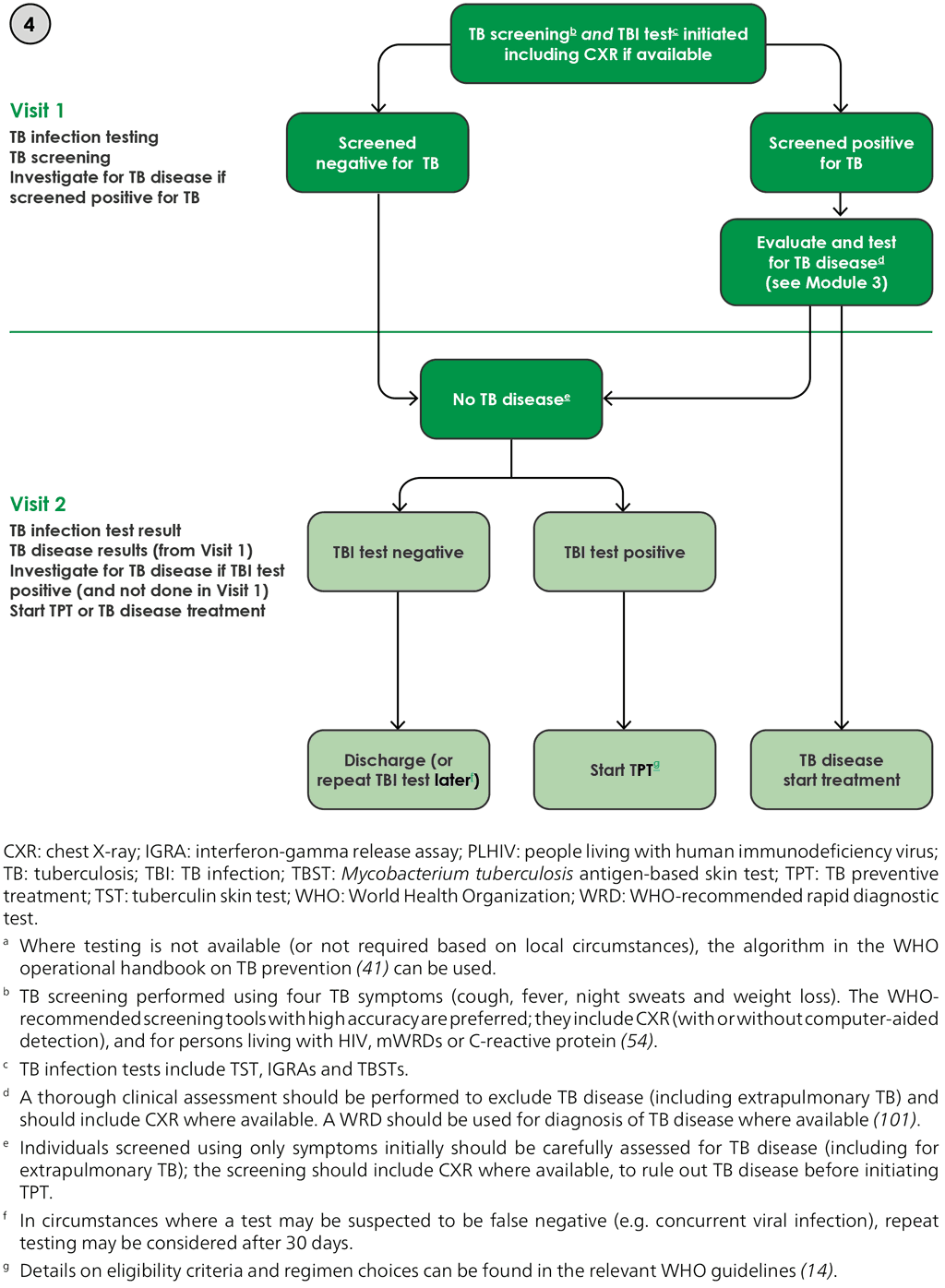Перекрёстные ссылки книги для 1266
An integrated algorithm for TPT among contacts (aged <5 years), people living with HIV and other risk groups has been released by WHO as Module 1 of the guidelines (17). For household contacts who are aged 5 years and older and who are not HIV-positive, testing for TB infection is advised as part of their care. Given that contacts are also at risk of TB disease, an integration of testing for TB infection with TB screening would be an important step to enhance implementation.
In the first visit, as soon as someone at risk of TB is identified, that person should undergo TB screening to detect people who should be tested for TB disease and should, at the same time, be tested for TB infection (Fig. 6.7). Children aged under 5 years and people living with HIV do not require testing for TB infection; for these groups, TPT can be initiated if TB disease can be ruled out. TB screening could be performed, for example, by assessing TB symptoms or using more sensitive WHO-recommended tools such as CXR, with or without computer-aided detection, mWRDs or C-reactive protein (the latter only applies to people living with HIV) (55). Sequential screening and diagnostic testing (first for TB disease, then for TB infection) may incur substantial delays or losses in testing for TB infection, particularly if these tasks are performed by different health care personnel or in different locations. Hence, during the first health care encounter, it is preferable to combine screening for TB disease with testing for TB infection. People with symptoms that are suggestive of TB disease should undergo further evaluation as soon as possible, preferably on the same visit (5). If onsite testing is available for TB disease and TB is confirmed, TB treatment should be promptly initiated, though this is unlikely in many settings.
The second visit may be optimized for the following: reading the TST or TBST or obtaining the IGRA result; reviewing the results of microbiological tests for TB disease if the person had a positive TB screen and submitted samples for TB testing; undertaking clinical evaluation to rule out TB or before starting TB treatment; and starting TPT or TB treatment. This second visit should occur 48–72 hours after the test. If the test for TB infection is negative, the individual can be discharged; however, a repeat test for TB infection may be required if an initial test is negative, particularly in people with very recent exposure or concomitant viral infection. When the test for TB infection is positive in contacts who were asymptomatic initially, or who had symptoms but in whom TB disease was excluded, the person should be re-evaluated for immediate initiation of TPT (Fig. 6.7). Although TB infection tests may be positive in the presence of TB disease, their low accuracy means that these tests are not recommended for screening or as part of the diagnostic work-up of presumptive TB; this should be emphasized during the training of health workers.
It is proposed that tests for TB infection for eligible individuals be conducted early in the assessment of people at risk of TB (i.e. during the first visit) because this would help to reduce delays in starting the appropriate treatment; also, the test result may be helpful when deciding the best course of action in most of the people tested. If a person has no symptoms at screening, evaluation to exclude TB disease may still be warranted, and CXR increases the sensitivity in such situations. Ideally, all these activities should be done on the same day, so that TPT can be prescribed during the second visit as soon as test results are available. Because most people with TB symptoms are not expected to have TB disease, deferring the test for TB infection to a later stage (e.g. after further work-up) in such individuals may result in significant losses.
Fig. 6.7. Algorithm for person-centred TB infection care; integrated infection and disease assessment where testing for TB infection is availableᵃ and recommended

The programmatic decision to initiate testing for TB infection implies a commitment to start TPT rapidly where indicated. Hence, the programme should ensure that the referral pathways and medical services are well organized before launching testing for TB infection, and that the mechanisms for clinical assessment, start of medication and treatment support are all available (Section 2). An advantage of skin testing for TB infection (using TST or TBST) is the capacity to administer the test and read the result in 48 hours at the POC. The portable nature of the supplies and temperature-controlled reagents needed for the test mean that testing can be done at home or in remote communities. However, these advantages are lost if the subsequent evaluation to exclude TB disease and the provision of TPT are not equally accessible. Hence, a decision to expand access to testing for TB infection needs to be matched by efforts to expand access to the medical services needed for management of those with positive test results.

 Обратная связь
Обратная связь